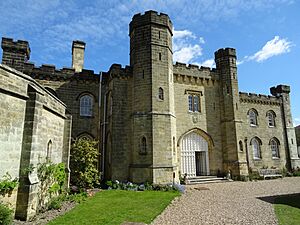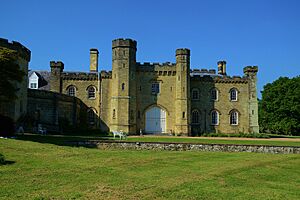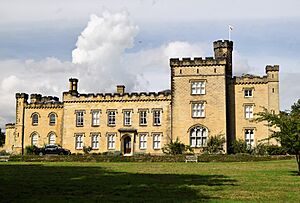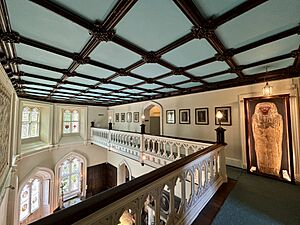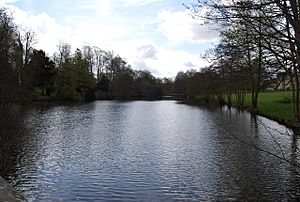Chiddingstone Castle facts for kids
Chiddingstone Castle is a historic building located in the village of Chiddingstone, near Edenbridge, Kent, England. It's about 35 miles (56 km) southeast of London, in the beautiful valley of the River Medway. This castle was built by the Streatfeild family. They lived there from the early 1500s until the early 1900s.
In 1938, the Streatfeild family sold the castle to Lord Astor. Since 1977, the castle and its 35 acres (14 hectares) of land have been looked after by a special group called the Denys Eyre Bower Bequest. They keep it open for everyone to visit. Most of the castle you see today was built in the early 1800s, but it includes parts of older buildings that were on the same spot.
History of Chiddingstone Castle
Early Days: High Street House
The first important building on this site was a timber-framed house. It was home to Richard Streatfeild, who was an iron master and wool merchant, starting in the early 1500s. Not much of this first house remains. In 1679, Henry Streatfeild (1639–1719) had the house rebuilt. It was made of red brick in a style popular during the Restoration period.
This building was known as High Street House or High Street Mansion. This was because it faced the village's main street. Later, in the 1800s, the land around the house was changed. This led to the village road being moved to where it is today.
Becoming Chiddingstone Castle
In the early 1800s, another Henry Streatfeild (1757–1829) wanted to rebuild the house. He hired an architect named William Atkinson to design it in the Gothic style. However, Atkinson's plan was not fully finished.
In 1835, Henry's son, also named Henry Streatfeild (1784–1852), hired architect Henry Kendal to do more work. The house was then renamed Chiddingstone Castle. Even though the Streatfeilds owned the castle until 1938, they stopped living there after 1900. During the Second World War, soldiers from the Canadian Forces stayed at the castle. After that, it became a school called Long Dene School until 1954.
Denys Eyre Bower's Vision
In 1955, a man named Denys Eyre Bower (1905–1977) bought the castle. He used to work at a bank and was an antiques dealer. He bought the castle to show off his amazing collections. Bower was born in Crich, Derbyshire, and started collecting things when he was very young.
He first worked as a bank clerk. Then, in 1943, he took over an antiques shop in Baker Street, London. When Baker Street was redeveloped, Bower moved to Chiddingstone Castle. He wanted to open his collections to the public there. He worked hard to make the castle a place for visitors. With the help of Ruth Eldridge and her sister Mary, he continued to open the castle to visitors until he passed away in 1977.
Chiddingstone Castle Today
When Denys Eyre Bower passed away, he left the castle and his collections to the nation. This led to the creation of the Denys Eyre Bower Bequest. This group continues to look after the castle and its collections. They keep it open to the public and it's also a popular place for weddings. Some of the current people in charge are descendants of the original Streatfeild family.
The castle is a Grade II* listed building, which means it's a very important historic site. The grounds also have other listed buildings, like an orangery. The grounds themselves are listed on the National Register of Historic Parks and Gardens. Chiddingstone Castle is an official museum. It has a tea-room where you can get refreshments. It also hosts many different events and activities throughout the year.
Fishing at the Castle Lake
The castle has a beautiful lake that is about 3.5 hectares (8.6 acres) in size. This lake separates the village of Chiddingstone from the castle grounds. It naturally has wild Carp, Bream, and Perch fish. For 37 years, starting in 1945, the lake held the record for the largest Bream ever caught.
Amazing Collections at the Castle
Denys Eyre Bower filled Chiddingstone Castle with incredible collections from around the world.
Japanese Collection
Bower became interested in collecting objects from Japan because his father was interested in Chinese porcelain. The castle's collection of lacquer is thought to be one of the most important private collections. You can also see swords, armour, and ancient clay figures called haniwa at the castle.
Ancient Egyptian Collection
The Ancient Egyptian collection covers the entire history of this ancient civilization. It includes items found in tombs, like ushabti figures (small statues meant to serve the dead) and amulets (charms). There are also everyday items, such as pots for food and drink. In 2013, some items from this collection were shown at the Houston Museum of Natural Science in their Hall of Ancient Egypt.
Stuart and Jacobite Collection
In British history, Denys Eyre Bower was very interested in the House of Stuart royal family and the Jacobitism movement. He was even a member of the Royal Stuart Society. His collection in this area includes portraits of Stuart family members. You can also see swords and objects with secret Jacobite symbols. The castle library has many old books about this topic on display.
Buddhist Collection
Bower's interest in objects related to Buddhism was very personal, as he was a Buddhist himself. Because of this, his collection doesn't focus on just one type of Buddhist belief or one country. Among the items displayed at the castle are thangkas (Tibetan Buddhist paintings) and images of Buddha.
Local History Displays
Besides Bower's collections, the castle's kitchen from the 1800s still has many of its original features. These include three special ovens for baking cakes. The kitchen is now used to display old kitchen tools and an ice chest. This shows that the castle once had an ice house to keep food cold. There is also a servants' hall and a servants' bedroom, giving a peek into how people lived and worked there long ago. The castle also keeps some old records about the local area's history.


